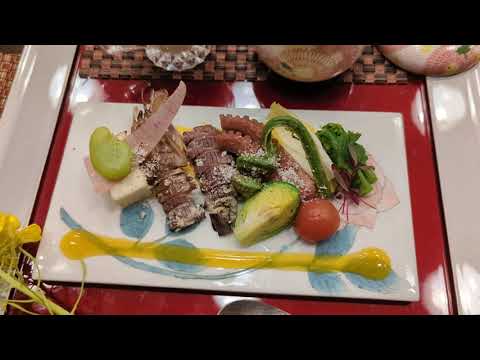Dinner at Migiwatei Ochi Kochi (汀邸 遠音近音), a luxury ryokan in the Tomonoura area of Japan (鞆町鞆.) The menu and explanations were in Japanese, but I’ve summarized each course below.
COURSE 1 – Reisai (冷菜 – Cold Appetizers):
* Setouchi Shako (瀬戸内蝦蛄 – Mantis Shrimp)
* Iidako Umani (飯蛸旨煮 – Simmered Webfoot Baby Octopus)
* Takenoko Sansho Shinjo (筍山椒真蒸 – Simmered Bamboo Shoots with Sansho Japanese Pepper)
* Tomato Pickles (トマトピクルス – Pickled Tomato)
* Mekyabetsu (芽キャベツ – Brussel Sprouts)
* Onomichi Wakegi (尾道分葱 – Wakegi Tree Onion)
* Endives (アンディーブ)
* Soramame (蚕豆 – Boiled Soramame Broad Beans)
* Nanohana (菜の花 – 菜の花 – Young Fern of a Rapeseed Plant)
* Kogomi (こごみ – Ostrich Fern)
* Amaranth (アマランサス)
* Koshin Daikon (紅芯大根 – Watermelon Radish)
* Tsukushi (土筆 – Field Horsetail)
* Sakura-ebi An (桜海老餡 – Sakura Shrimp with An Sauce)
* Suizenji Nori (水前寺海苔 – Suizenji Nori Seaweed.
* Serasan Matsu Nameko (世羅産松なめこ – Nameko Fungus taken directly off Pine Trees)
– Unohana/Okara Shiso Fumi (卯の花/おから紫蘇風味 – Shiso-flavored Simmered Soy Pulp)
– Shiki Kimizu (敷き黄身酢 – Vinegared Egg Yolk)
* Usui to Goma no Yawaraka Nishoku Tofu (碓井と胡麻の柔らか二色豆腐 – Usui Pea and Sesame with two types of Tofu)
* Aburame (Ainame) Karaage (油目 (鮎魚女) 唐揚げ – Deep-fried Fat Greenling)
* Kurogome Okowa (黒米お強) – Steamed Glutinous Black Rice
– Urui Ankake (うるい庵かけ – Urui with Ankake Sauce)
COURSE 2 – Otsukuri (御造り – Sashimi):
* Chi Anago Usuzukuri Ozaramori (地穴子薄造り大皿盛り – Thinly sliced raw Conger Eel & Conger Eel Skin)
* Ko Iwashi Otsukuri (小鰯御造り – Sardine Sashimi)
* Akanishigai (赤西貝 – Akanishigai Japanese Rapa Whelk)
* Sakura Daikon ni Tai Sakuraba Tsutsumi (桜大根に鯛桜葉包み – Pickled Daikon Radish and Red Sea Bream wrapped in Sakura Leaves)
* Sayori (細魚 – Japanese Halfbeak)
* Tachiuo (太刀魚 – Cutlass Fish)
* FOR HIM: Kuruma-ebi Yubiki (車海老湯引き – Boiled Tiger Prawn)
* FOR HER: Sawara (鰆 – Spanish Mackerel)
COURSE 3 – Konro (焜炉 – Konro Grill):
* Okoze Shabu-nabe (虎魚しゃぶ鍋 – Stonefish Hot Pot)
– Okoze Kawa (虎魚皮 – Stonefish Skin)
– Haru Kyabetsu (春キャベツ – Spring Cabbage)
– Seri (芹 – Oenanthe javanica, which is part of the Japanese wild parsely family)
– Wakame & Udo (若芽と独活 – Wakame Seaweed & Aralia Cordata leaf)
– Hatsukaichi-san Awabidake (廿日市産あわび茸 – Bailingu Oyster Mushrooms from Hatsukaichi in Hiroshima)
– Tai Mako (鯛真子 – Red Sea Bream Ovaries)
– Tofu (豆腐)
– Kaben Ninjin (花弁人参 – Carrots cut in the shape of a flower)
– Sudachi (酢橘 – Sudachi Citrus)
– Ponzu (ポン酢 – Ponzu Sauce)
COURSE 4 – Sunomono (酢の物 – Vinegared Dish):
* Mushi Awabi & Awabi Kimo (蒸し鮑と鮑肝 – Steamed Abalone & Liver)
* Tairagi-kai Yakishimo (タイラギ貝焼霜 – Pen Shell grilled over an open flame and immediately cooled with cold water. This removes fishy odors and excess fat to increase flavor)
* Takenoko Umani (竹の子旨煮 – Simmered Bamboo Shoots)
* Ashitaba (明日葉 – Ashitaba (Angelica Keiskei), a flowering plant in the carrot family native to Japan)
* Yaki Shiitake (焼き椎茸 – Grilled Shiitake Mushrooms)
* Tataki Warabi Oka Jule-kake (叩き蕨桜花ジュレかけ – Bracken & Sakura Flower Jelly Sauce)
COURSE 5 (FOR HIM):
Niku Ryori (肉料理 – Meat Dish):
* Takehara-san Taoshita Gyu Filet Kuro Kosho Yaki (竹原さん 垰下牛フィレ 黒胡椒焼き – Pepper-grilled Taoshita Wagyu Filet)
– Yomogi Tofu Croquette (蓬豆腐コロッケ – Mugwort Tofu Croquette)
– Nankin-fu (南京麩 – Wheat Gluten)
– Fukinoto Tempura (蕗の薹天婦羅 – Tempura of an Edible flower bud of the Fuki Butterbur plant)
– Karasumi Ogon-age (唐墨黄金揚げ – Mullet Roe deep fried with Egg Yolk and Flour batter dissolved in water )
– Aspara (アスパラ – Asparagus)
– Hari Gobo (針牛蒡 – Thinly cut fried Burdock Roots)
– Kinome Miso (木の芽味噌 – Miso mixed with the Young leaves of a Sansho plant)
– Yaki Lemon (焼き檸檬 – Grilled Lemon)
COURSE 5 (FOR HER):
Abura-mono (油物 – Fried Dish):
* Anago Tempura (穴子天婦羅 – Conger Eel Tempura)
– Age Kuzukiri (揚げ葛切り – Fried Kuzukiri. Kuzukiri is a transparent noodle made from water and kudzu powder)
– Fukinoto (蕗の薹 – Edible flower bud of the Fuki Butterbur plant)
– Nasu (茄子 – Japanese Eggplant)
– Renkon (蓮根 – Lotus Root)
– Shiitake (椎茸 – Shiitake Mushrooms)
– Karasumi Ogon-age (唐墨黄金揚げ – Mullet Roe deep fried with Egg Yolk and Flour batter dissolved in water )
– Aspara (アスパラ – Asparagus)
– Ten Dashi (天出汁 – Tempura Dashi Sauce)
– Sakura Shio (桜塩 – Cherry Salt)
COURSE 6:
* Okoze Karaage (虎魚唐揚げ – Deep-fried Stonefish)
COURSE 7 – Oshokuji (御食事 – Rice Dish):
* Tai Kamameshi (鯛釜飯 – Rice with Red Sea Bream cooked in an iron pot called a “Kama.” It is first to be consumed as-is, then enjoyed – “Ochazuke” style – by adding Konbu Dashi Soup along with additional condiments (Arare, Nori, Myoga Japanese Ginger & Wasabi))
* Kounomono (香の物 – Pickled Vegetables)
COURSE 8 – Mizugashi (水菓子 – Dessert):
* Shin Junsai, Blueberry, Kuromitsu Sauce (新順菜, ブルーベリー, 黒蜜ソース – Water Shield Aquatic Plant with Blueberries and Japanese black sugar syrup)
* Shimanami Kankitsu to Matcha Mousse & Lime Jule (しまなみ柑橘と抹茶ムース, ライムジュレ – Citrus from Shimanami and Matcha Green Tea Mousse with Lime Jelly)

